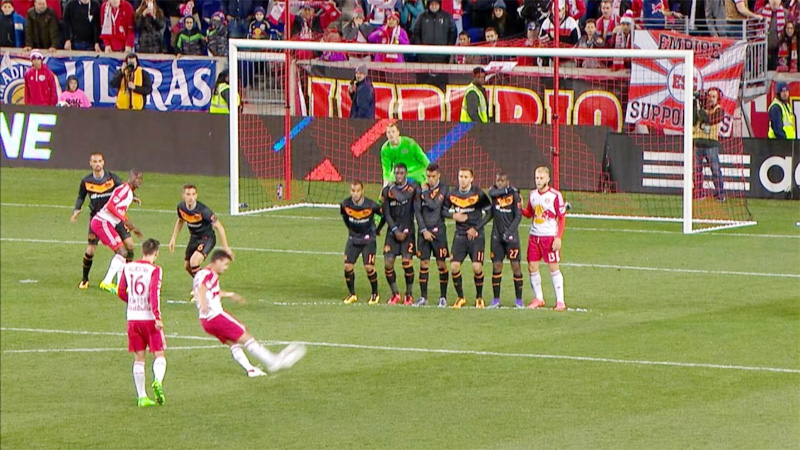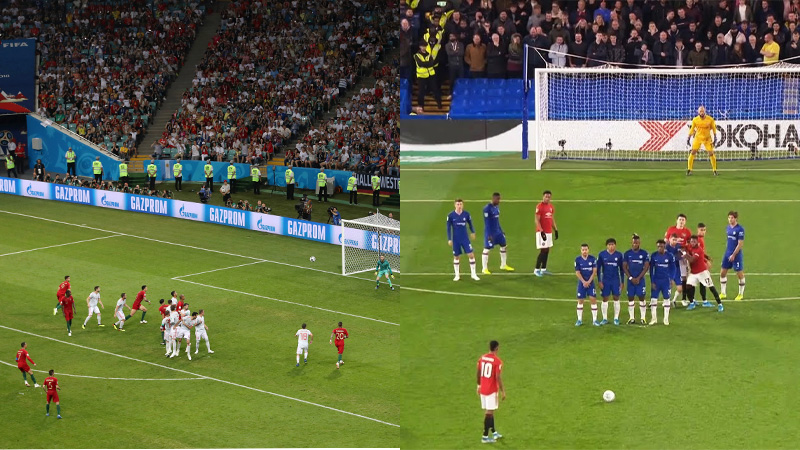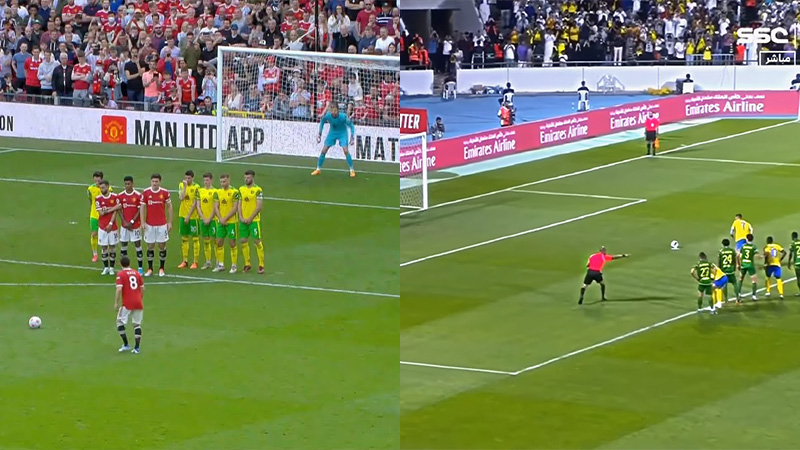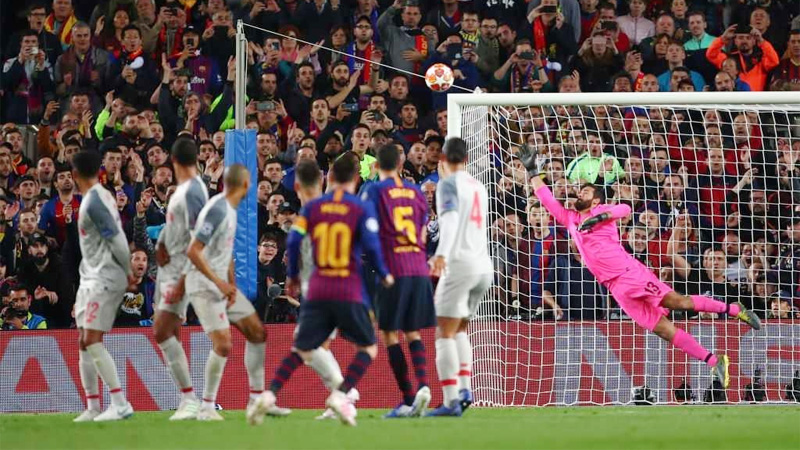In the captivating world of soccer, the art of the direct free kick rules over set-piece situations, offering players and teams an exhilarating opportunity to showcase their skills and score spectacular goals.
Direct free kicks are awarded to the non-offending team when the opposing side commits a more serious foul or violation.
As one of the most anticipated moments in a match, direct free kicks grant the attacking team the chance to shoot directly at the goal without the ball needing to touch another player before finding the net.
The defensive wall, constructed by the defending team, adds an element of drama and tactical complexity as players aim to outwit their opponents with precision and power.
In this article, we explore the intricacies of soccer’s direct free-kick rules, delving into how these moments of sheer brilliance can swing the momentum of a match and leave fans in awe of the players’ technical prowess.
What Is a Free Kick?
A free-kick is a method of restarting play in soccer after a foul or violation has been committed by the opposing team.
It is one of the most crucial set-piece situations in the game and can present goal-scoring opportunities or allow teams to regain possession and build an attack.
When a foul occurs, the referee stops play and awards a free-kick to the non-offending team at the location where the foul took place.
There are two main types of free-kicks in soccer:
Direct Free-Kick
In a direct free-kick, the player taking the kick can score directly from the set piece without the ball needing to touch another player.
The opposition sets up a defensive wall, and the free-kick taker aims to shoot the ball past or over the wall into the goal.
Indirect Free-Kick
In an indirect free-kick, the ball must touch another player from either team before a goal can be scored.
This means that the ball cannot go directly into the net from the kick; it must touch another player first. Indirect free-kicks are typically awarded for less severe fouls or violations.
Both direct and indirect free-kicks offer teams valuable opportunities to capitalize on their offensive skills, employ strategic set-piece plays, and put pressure on the opposing defense.
The success of a free kick depends on the accuracy, power, and finesse of the player taking the kick, as well as the defensive organization and coordination of the opposing team.
Soccer Direct Free Kick rules

Direct free kicks are crucial set-piece situations in soccer, presenting teams with the opportunity to score directly without the ball touching another player before entering the goal.
Understanding the rules surrounding direct free kicks is essential for players, coaches, and fans alike.
Here’s a breakdown of the rules governing direct free kicks in soccer:
Foul or Violation
A direct free kick is awarded to the non-offending team when the opposing team commits a foul or violation.
Common fouls include tripping, pushing, holding, handball, and reckless challenges.
The referee signals for a direct free kick by pointing in the direction of the attacking team and placing the ball at the spot where the foul occurred.
Defensive Wall
When a direct free kick is awarded near the goal, the defending team is allowed to construct a defensive wall of players between the ball and the goal.
The wall’s purpose is to block the path of the ball and make it more challenging for the free-kick taker to score.
The wall must be at least 10 yards (9.15 meters) away from the ball and cannot interfere with the free-kick taker’s movement.
Indirect Touch
The ball is considered in play as soon as it is kicked and moves. Unlike indirect free kicks, players can score directly from a direct free kick without the ball needing to touch another player before finding the net.
The free-kick taker can aim to shoot the ball over the wall, around the wall, or under the wall to beat the goalkeeper and score a goal.
Encroachment
Both attacking and defending players are not allowed to encroach within 10 yards of the ball until it is in play.
If a player from either team enters this zone before the ball is kicked, the referee may caution them with a yellow card for unsporting behavior.
f encroachment impacts the outcome of the free kick, the kick may be retaken.
Retakes
The referee may order a retake of a direct free kick if any player from the attacking team enters the penalty area or any player from the defending team encroaches into the 10-yard zone before the ball is kicked.
Additionally, if the free-kick taker takes an excessive amount of time to kick the ball, the referee may also call for a retake or penalize the delay with a yellow card.
Direct free kicks are moments of excitement and tension in soccer matches, offering teams the opportunity to score goals from set-piece situations.
The skill and precision of the free-kick taker, combined with the defensive organization of the opposing team, can determine the outcome of the kick and potentially swing the momentum of the game.
Coaches often devise strategic plays and practice various free-kick techniques to make the most of these critical moments on the field.
Indirect vs. Direct Free kick

Indirect Free Kick: An indirect free kick is a method of restarting play in soccer after a less severe foul or violation has been committed by the opposing team. Unlike direct free kicks, the ball must touch another player from either team before a goal can be scored.
Indirect free kicks are typically awarded for offenses such as dangerous play, obstruction, the goalkeeper handling the ball after a teammate passes it directly to them, and other less serious fouls.
When the referee awards an indirect free kick, they raise their arm above their head to indicate that the kick is indirect.
This signals to both teams that the ball must touch another player before a goal can be scored.
Indirect free kicks are taken from the spot where the foul occurred, and the defending team is allowed to construct a wall, although the wall is generally less critical in these situations as a goal cannot be scored directly from the kick.
Direct Free Kick
A direct free kick is another method of restarting play in soccer after a more serious foul or violation has been committed by the opposing team. In contrast to indirect free kicks, a goal can be scored directly from a direct free kick without the ball touching another player before entering the net.
Common fouls that result in direct free kicks include tripping, pushing, holding, reckless challenges, and handball.
The referee signals for a direct free kick by pointing in the direction of the attacking team and placing the ball at the spot where the foul occurred. The defending team is allowed to construct a defensive wall to block the path of the ball and make it more challenging for the free-kick taker to score.
Direct free kicks are excellent goal-scoring opportunities, and skilled free-kick takers can significantly impact the outcome of a match by converting these set-piece situations into goals.
Penalty Kick Vs. Free-Kick

Here are some descriptions between penalty kicks and free kicks-
Penalty Kick
A penalty kick is a critical and high-stakes situation in soccer that occurs when a defending player commits a foul inside their own penalty area, resulting in a direct free kick for the attacking team from the penalty spot.
The penalty spot is located 12 yards (11 meters) away from the center of the goal line.
When a penalty kick is awarded, the player taking the kick, known as the penalty taker, has the opportunity to shoot the ball directly at the goal, with only the opposing goalkeeper standing between them and the net.
No other players are allowed inside the penalty area during the penalty kick except for the goalkeeper and the penalty taker.
The goalkeeper’s objective is to make a save and prevent the ball from entering the goal, while the penalty taker aims to score with precision and power.
Penalty kicks are decisive moments in matches, often determining the outcome of games and leading to moments of intense pressure and drama.
Free-Kick
A free-kick is a method of restarting play in soccer after a foul or violation has been committed by the opposing team. It can occur anywhere on the field, outside of the penalty area.
Free-kicks are of two types: direct and indirect. In a direct free kick, the attacking team has the opportunity to score directly without the ball touching another player before entering the net.
The defending team constructs a defensive wall to block the path of the ball. In an indirect free kick, the ball must touch another player from either team before a goal can be scored.
Both types of free-kicks offer teams opportunities to create goal-scoring chances or regain possession and build attacks.
Unlike penalty kicks, free kicks are taken from the spot where the foul occurred, and multiple players from both teams can be involved in the set piece.
Skillful free-kick takers can significantly impact a match’s outcome, making free-kicks vital in showcasing a team’s tactical acumen and individual talent.
FAQ
What is a direct free kick in soccer?
A direct free kick is a method of restarting play in soccer after a more serious foul or violation has been committed by the opposing team. When a direct free kick is awarded, the attacking team has the opportunity to shoot directly at the goal without the ball needing to touch another player before entering the net.
When is a direct free kick awarded?
A direct free kick is awarded to the non-offending team when the opposing team commits a more severe foul or violation. Common fouls that result in a direct free kick include tripping, pushing, holding, reckless challenges, and handball.
How far should the defensive wall be from the ball during a direct free kick?
The defending team is allowed to construct a defensive wall to block the path of the ball during a direct free kick. The wall must be positioned at least 10 yards (9.15 meters) away from the ball.
Can a goal be scored directly from an indirect free kick?
No, a goal cannot be scored directly from an indirect free kick. Unlike direct free kicks, where a goal can be scored without the ball touching another player, in an indirect free kick, the ball must touch another player from either team before a goal can be scored.
What happens if the free-kick taker takes too much time to kick the ball?
If the free-kick taker takes an excessive amount of time to kick the ball, the referee may penalize the delay by cautioning the player with a yellow card. The referee will allow a reasonable amount of time for the player to set up the free kick, but if there is an intentional delay to waste time or disrupt the flow of play, a caution may be given.
Conclusion
Soccer’s direct free-kick rules encapsulate the essence of drama, precision, and artistry on the field, adding a touch of excitement to the beautiful game.
From the spot where fouls are committed, players get to showcase their finesse in bending the ball around defensive walls, launching powerful strikes, or surprising goalkeepers with clever techniques.
The ability to convert direct free kicks into goals can be a game-changer, turning the tide of a match and securing victories for teams.
As fans hold their breath, awaiting the outcome of these high-pressure moments, players demonstrate their expertise and a single direct free kick can become an unforgettable highlight in the history of soccer.
Whether it’s the audacious chip over the wall or the thunderous shot that rattles the net, direct free kicks epitomize the spirit of the sport, celebrating individual brilliance and team tactics in equal measure.







